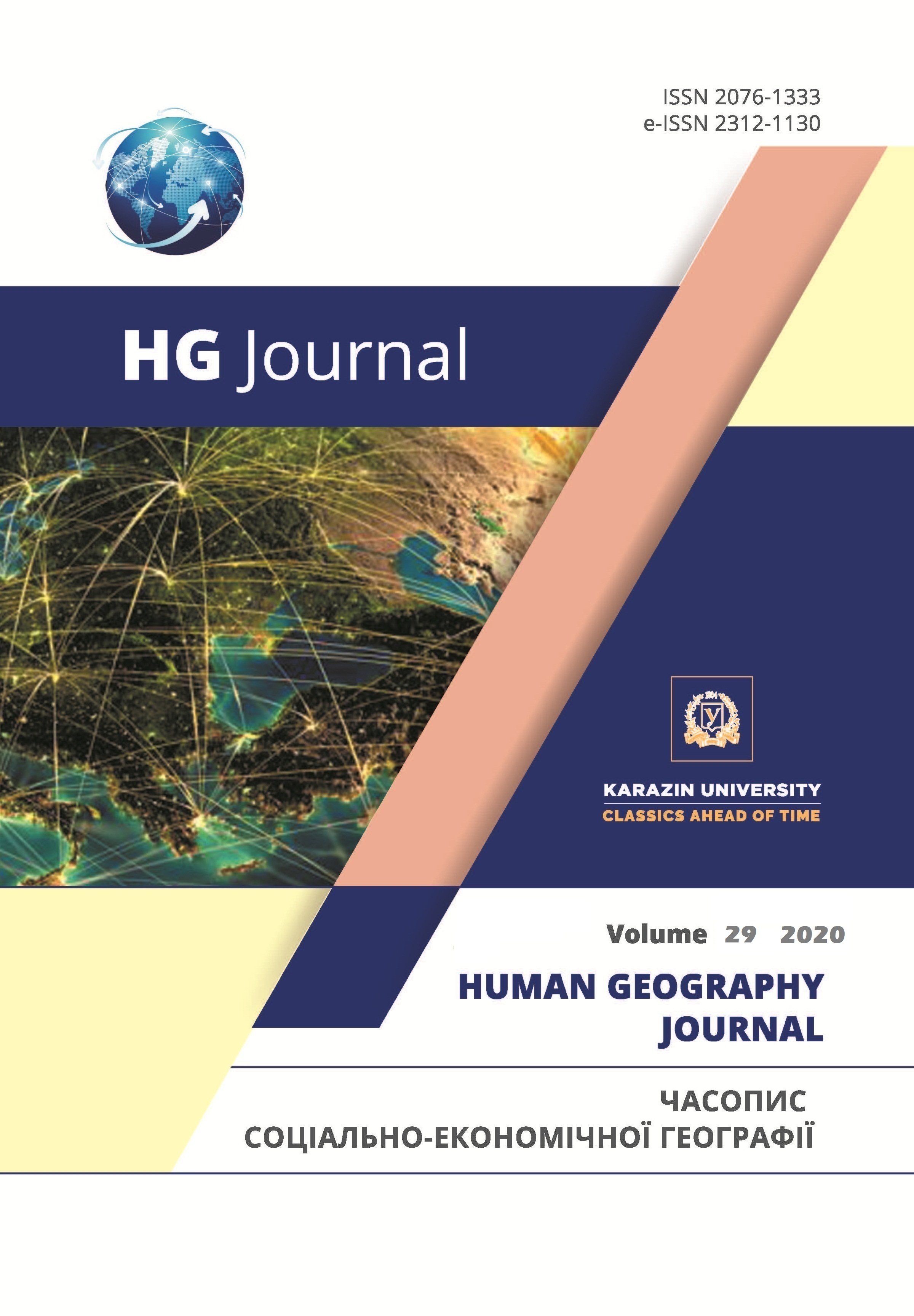Regional settlement systems in Ukraine: features of development in terms of decentralization reform
Abstract
Administrative and territorial reform in Ukraine is an extremely important stage in the development of our country. Decentralization creates new challenges for the regions, gives local authorities new powers, duties and responsibilities. For a comprehensive analysis of the possibilities and prospects of decentralization reform, it is important to analyze the existing world experience in implementing of the similar regional development programs in different countries. The implementation of such reforms in highly developed and developed countries is usually more successful than in developing countries, mainly due to the unpreparedness of local governments to the transformation of socio-political relations. Domestic and foreign scholars who have researched the course of decentralization reform in Ukraine note that it is extremely important to make appropriate changes to the Constitution of Ukraine and consolidate them at the highest state level. Decentralization reform, of course, cannot be considered as a universal tool for solving all existing problems of Ukraine, but it is an extremely important step towards comprehensive development of our country, taking into account the needs of the state and regions, the specifics of each, and the possibility for more effective implementation of regional policy measures by expanding the powers of local authorities.
Thus, according to the new division, the largest districts in terms of population, the centers of which are the largest cities in Ukraine: Kharkiv, Odesa and Dnipro, which account for 4.8%, 3.8% and 3.2% of the population of the country's districts, respectively. Zaporizhia district of Zaporizhia region, Lviv district of Lviv region account for 2.4-2.1% of the population. Based on the cluster analysis of 119 newly formed districts of Ukraine by the Ward method, according to 24 indicators as of 2020, 8 clusters were identified. Cluster analysis of the regions of Ukraine by a similar method according to the level of urbanization allowed to identify 6 clusters. The established features should be taken into account in forming plans and programs of regional development, which should be scientifically substantiated, take into account the peculiarities of decentralization of power and contribute to improving the level and quality of life of the population.
Downloads
References
Administrative-territorial structure of Ukraine: methodological bases and practice of reforming: monograph (2016). Lviv [in Ukrainian].
Baranovskyi, M.O. (2017). Finansova detsentralizatsiya v Ukraini: osoblyvosti stanovlennya [Financial decentrali-zation in Ukraine: features of formation]. Ukrainskyi geografichnyi zhurnal, 4, 30-38 [in Ukrainian].
Bardhan, P. (2002). Decentralization of Governance and Development. Journal of Economic Perspectives, 16(4), 185-205.
Connerley, E., Kent, E., & Smoke, P. (2010). Making Decentralization Work: Democracy, Development, and Security. Boulder, CO: Lynne Rienner, 263 p.
Dudley, W. (2019). Ukraine’s Decentralization Reform. SWP Working Papers, № 1. Retrieved from https://www.swp-berlin.org/fileadmin/contents/products/arbeitspapiere/Ukraine_Decentralization_Dudley.pdf.
Faguet, Jean-Paul (2011). Decentralization and governance. Economic Organisation and Public Policy Discussion Pa-pers, EOPP 027. London School of Economics and Political Science, London, UK. Retrieved from http://eprints.lse.ac.uk/37346/
Firman, T. (2010). Decentralization reform and local-government proliferation in Indonesia: Towards a fragmentation of regional development. Review of Urban and Regional Development Studies, 21(2‐3), 143-157.
Kravchenko, K. (2017). Prostorovi osoblyvosti, problemy ta perspektyvy formuvannya obyednanykh terytorialnykh hromad u Kharkivskiy oblasti [Spatial Features, Problems and Prospects of the United Territorial Communities For-mation in Ukraine]. Chasopys sotsialno-ekonomichnoi geografii – Human Geography Journal, 22, 174-179 [in Ukrainian].
Melnychuk, A., & Hanichenko, K. (2020). Pyat rokiv formuvannya obyednanykh terytorialnykh hromad v Ukraini: efektyvnist ta efekty administratyvnoho zavershennya etapu reformy na prykladi Kyivskoi oblasti [Five years of for-mation of united territorial communities in Ukraine: efficiency and effects of administrative completion of the reform stage on the example of Kyiv region]. Naukovyi visnyk KhDU: Seriya Geografichni nauky, 12, 17-24 [in Ukrainian].
Minas, R., Wright, S. & van Berkel, R. (2012). Decentralization and centralization: Governing the activation of social assistance recipients in Europe. International Journal of Sociology and Social Policy, 32, 5/6, 286-298.
Niemets, K., Kravchenko, K., Mazurova, А., Sehida, К. & Lurie, A. (2018). Regional settlement system as a basis for the formation of growth poles (case of Kharkiv region). Chasopys sotsialno-ekonomichnoi geografii – Human Geogra-phy Journal, 24, 39-48.
Niemets L., Sehida K., Kravchenko K., Telebienieva I., & Peresadko V. (2018). Trends Forming Policentric Model of Spatial Development and Implementation of the European Experience for Ukraine. Proceedings of the 32nd Interna-tional Business Information Management Association Conference, 362-374.
Niemets, K.A., Sehida, K.Yu, Niemets, L.M., Kravchenko, K.О., Telebienieva, Ye.,Yu., Klyuchko, L.V., & Redin, V.I. (2019). Doslidzhennya miskykh aglomeratsiy v aspekti realizatsii administratyvno-terytorialnoi reformy v Ukraini (na prykladi Kharkivskoi oblasti) [Research of urban agglomerations in the aspect of implementation of administrative-territorial reform in Ukraine (on the example of Kharkiv region)]. Chasopys sotsialno-ekonomichnoi geografii – Human Geography Journal. Kharkiv: KhNU imeni V.N. Karazina, 27, 28-39 [in Ukrainian].
Ofitsiinyi sait Detsentralizatsiya v Ukraini: novi mozhlyvosti. Retrieved from https://decentralization.gov.ua [in Ukrainian].
Ofitsiinyi sait Derzhavnoi sluzhby statystyky Ukrainy. Retrieved from http://www.ukrstat.gov.ua [in Ukrainian].
Pelekhatyi, A., & Zakhidna, O. (2014). Administratyvno-terytorialna reforma yak instrument detsentralizatsii fi-nansovykh resursiv [Administrative-territorial reform as an instrument of decentralization of financial resources]. Sotsi-alno-ekonomichni problemy suchasnoho periodu Ukrainy, 4, 167-175.
Postanova Verkhovnoi Rady Ukrainy Pro utvorennya ta likvidatsiyu rayoniv. Retrieved from https://zakon.rada.gov.ua/laws/show/807-IX#Text [in Ukrainian].
Smoke, P. (2015). Rethinking Decentralization: Assessing Challenges to a Popular Public Sector Reform. Special Issue: Public Administration for Development: Trends and the Way Forward, 35(2), 97-112.
Uriadovyi portal / Normatyvno-pravovi akty / Rozporiadzhennya shchodo vyznachennya administratyvnykh tsentriv ta zatverdzhennya terytoriy hromad oblastei, 12 chervnya 2020 roku. Retrieved from https://decentralization.gov.ua/gromadas [in Ukrainian].
Copyright (c) 2020 © Niemets L., Sehida K., Kravchenko K., Telebienieva I., Pohrebskyi T., 2020

This work is licensed under a Creative Commons Attribution 4.0 International License.




